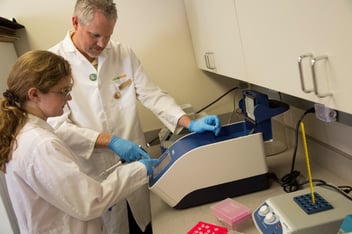
Page content:
-
Combining two technologies to broaden rapid molecular test platform horizons
-
Triple threat: speed, sensitivity, and specificity
-
The impact of raw material selection: DNA polymerase
-
DNA Polymerase: 1-Step, 1-Enzyme or 2-Steps, 2-Enzymes for RT-qPCR?
-
The future of DNA polymerase
Rapid molecular test platforms targeting the viral genome based on real-time quantitative polymerase chain reaction (RT-qPCR) facilitate speed, sensitivity, and scale for laboratory diagnoses not possible with conventional microbiology. R&D labs and IVD manufacturers worldwide are racing to innovate rapid, versatile, and robust point of care molecular platforms; however, the question of how best to approach this is complex. We caught up with Dr John Goh, Senior Research Scientist at Veredus Laboratories, to get his expert advice, based on his real-world experience, on the key raw material considerations for the development of these platforms.
Since the first direct-specimen molecular testing for infectious diseases was approved by the US FDA 26 years ago, there has been a recent explosion in direct-specimen rapid amplification and detection platforms. But what are the primary design requirements R&D scientists need to consider when developing the next generation of rapid molecular test platforms targeting the viral genome? We spoke to Dr John Goh, Senior Research Scientist at Veredus Laboratories, to discuss his experience of developing assays and applications with the cutting-edge PCR microarray VereChip™ Lab-on-Chip platform.
Combining two technologies to broaden rapid molecular test platform horizons
While microarrays can simultaneously analyse multiple genes, their system-level sensitivity is relatively low. Conversely, PCR is restricted in the number of targets that can be faithfully amplified simultaneously, because of uncontrollable primer–primer interactions. By combining the two methods, the capacity for specificity is enhanced. VereChip™ technology integrates both PCR and microarray technology, to bring about innovative multiplexing capabilities.
“This ability to capture multiple targets means that co-infections of infectious diseases can be determined within a single assay.” Says Dr Goh, “We have developed the design process of the microarray probes such that we are able to distinguish between DNA sequences to the extent of single nucleotide polymorphisms.” Using this capability, Dr Goh has been able to extend the scope of this assay to criminal forensics; “this has been a very exciting extension of our Lab on Chip (LOC) platform. The turn-around time for this assay including sample extraction and pre-amplification is about 3 hours.”
Triple threat: speed, sensitivity and specificity
The global pandemic placed undue emphasis on rapid assay turnaround to limit the spread of transmission. Dr Goh agrees “from the experience of Covid-19, the turn-around time for the assay has been shown to be an essential feature of the assay”. This has had a significant impact on the in vitro diagnostics field, with a stronger focus on “aiming to cut-out the extraction time to save time.”
“…from the experience of Covid-19, the turn-around time for the assay has been shown to be an essential feature of the assay”
Above speed, what did Dr Goh consider to be the primary design requirements when developing his COVID-19 assay? “The focus when approaching assay kit development in my own opinion is the specificity and sensitivity of the assay. This is because when undergoing clinical evaluation, the authorities will definitely be looking at the data in terms of the number of false-negatives and false-positives as predicted by the assay.”
With regards to the specificity, Dr Goh goes on to explain “due to the possibility of mutations as the infectious disease evolves, several gene targets of the pathogen are included to not only improve robustness but also to guarantee that should any mutations occur, there are back-up targets that will ensure the relevance of the assay.”
The impact of raw material selection: DNA polymerase
Ultimately, speed, specificity and sensitivity can only be achieved with the selection of the appropriate raw material. Of the five core components of a PCR mix, DNA polymerase is an essential consideration.
“There are many components that make up the assay, but the component I wish to highlight is the enzyme mix for the assay”
Regarding DNA polymerase performance, Dr Goh highlights the importance of the enzyme mix for a given assay; indeed, consideration of PCR-enhancing agents can optimise enzyme performance and allow efficient amplification. “Additives are also often added to improve the robustness against PCR inhibition. In terms of risk management” says Dr Goh “it is one of the most important factors to consider because it is essential to the performance of the assay. The enzyme mix is prone to temperature fluctuations, and any variation will have an impact on the specificity and sensitivity of the assay.”
DNA Polymerase: 1-Step, 1-Enzyme or 2-Steps, 2-Enzymes for RT-qPCR?
A host of factors affect the choice between one-step RT-qPCR or two-step RT-qPCR; however, the trend towards rapid turnaround has fueled the one-step approach. Does Dr Goh agree? “For a molecular diagnostic device, a one-step enzyme system is definitely preferred, especially when you take into consideration the ease-of-use.” With one-step RT-PCR, dual reverse transcription (RT) and qPCR steps are conducted in the same reaction; this complies with the quantitative real-time nature of PCR tests dominating molecular diagnostic methodologies. It also bypasses the difficulties in optimising conditions to simultaneously meet the requirements of the reverse transcriptase and DNA polymerase enzymes in the two-step approach. With one-step a firm winner in viral-targeting real-time quantitative diagnostics, a bifunctional thermostable DNA polymerase with dual DNA polymerase and reverse transcriptase activities is required. What enzymes are on offer?
“The first one-enzyme assay system was the Tth DNA Polymerase enzyme that could perform both reverse transcription and DNA polymerase functions” says Dr Goh. Derived from the thermophilic bacteria Thermus thermophilus (Tth) HB8, Tth DNA polymerase is thermostable, possessing reverse transcriptase activity in addition to a 5’→3’ polymerase activity and a double strand specific 5’→3’ exonuclease activity in the presence of Mn2+ ions. Pertinent to the challenge of viral targets for amplification, Tth DNA Polymerase is effective for reverse transcription of RNA with complicated secondary structure due to the reaction occurring at high temperatures.
TTx DNA Polymerase is the next generation of Tth DNA Polymerase-like enzymes, also offering the option of a one-enzyme system. Like Tth, TTx DNA Polymerase exhibits reverse transcriptase activity in the presence of Mn2+ ions with fast and effective amplification from crude samples. Dr Goh goes on to say, “this system might be preferable for several reasons:
-
Ease of quality control. A one enzyme system represents a simplification in the quality control checks, as fewer components are involved.
-
Better customer experience. We have previously required our customers to pipette different components including both the reverse transcriptase and polymerase enzymes. Having a one enzyme system would certainly enhance the ease of use of the assay.”
“I find that the performance is comparable if not better.”
What has been Dr Goh’s experience with the reverse transcription performance of his enzyme choices for one-enzyme assay systems? “We have recently explored the use of TTx DNA Polymerase by switching out the existing enzyme mix in the existing SARS-COV 2 assays both on the LOC platform and real-time PCR. Based on very preliminary trials, I find that the performance is comparable if not better” he says, “I hypothesise that the advantage of being able to run at a higher reverse transcription temperature might result in better performance.” Between Tth and TTx DNA Polymerase, Dr Goh explains “TTx DNA Polymerase can carry out the step at 60 °C, which would be more ideal to overcome possible secondary mRNA structures that hinder this step. Possibly due to the higher temperature, we have also been able to restrict the reverse transcription step to 5 minutes in preliminary studies with satisfactory results.”
The future of DNA polymerase
Circling back to the role of additives in increasing DNA polymerase stability – there are exciting developments in the pipeline. Dr Goh has previously worked with glycerol free enzymes, for which there has been a lot of interest in the last few years. While glycerol plays a cryoprotectant role, it poses a roadblock to protein lyophilization. With “lyo-ready” products offering a wealth of advantages from improved user experience to large-scale economic and environmental benefits, they are an attractive option for R&D scientists. As such, alternative solutions have been developed, with recent trends including lyophilised nucleic acid-based molecular point-of-care assays. What is the main attraction for Dr Goh? “This approach would improve the customer experience because all the customer needs to do is to reconstitute the single reaction mix and add the extracted sample.”
In addition to the ease of reconstitution, a further benefit is the ambient temperature stability – which circumvents the cold transport & storage requirements of conventional PCR reagents. With benefits like this to both the reagent supply industry and the end-user, Dr Goh continues “the tests can be brought to out-field stations without the usual amenities that exist in a conventional lab. The company is also able to reduce costs in cold-chain shipment as an added benefit.”
“The sensitivity and specificity of the assay should not be compromised as a result of the lyophilisation process”
But glycerol-free enzymes are not without their challenges “different vendors have their unique lyophilisation processes and additives to stabilise the enzyme mix. Further studies regarding the final lyophilised reagent and the compatibility with the assay must be carried out” says Dr Goh, “the cost of lyophilisation also needs to be managed carefully to minimise the cost of goods.”
Ultimately, what is Dr Goh’ s takeaway? “the prospect of providing lyophilised reagents to our customers as part of the assay kit is exciting…. we feel this would be the way forward.”
With the future of rapid molecular test platforms encompassing RT-qPCR, endpoint PCR with microfluidics and array technologies, and integrated platforms, the choice of raw materials– in particular, DNA polymerase – has the capacity to improve the speed, sensitivity, and specificity they can offer.
With over 35 years’ experience, SEKISUI Diagnostics addresses the challenge of rapid and efficient one-step RT-qPCR assays. With high-performance enzymes, delivering high amplification efficiency, SEKISUI enables R&D scientists to develop and deliver rapid molecular platforms with versatile applications from forensics, through food surveillance, to rapid POC testing of infectious disease.
Click here to learn more about TTx DNA polymerase



Share Article